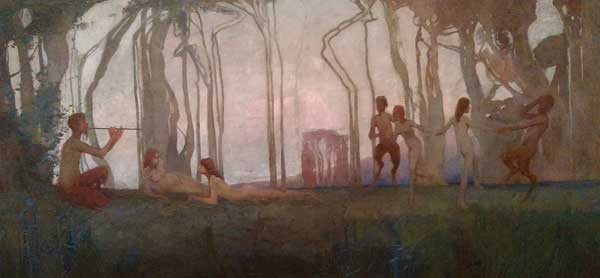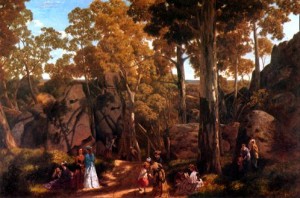Shadows & Influence

LITERARY & CULTURAL SPELLS CAST UPON LADY JOAN LINDSAY AND PICNIC AT HANGING ROCK
Joan Lindsay was born (1896) when Romanticism still cast its attractively unwholesome shadow and wrote her unique novel (1967) at the height of the Summer of Love (in which year the Australian Prime Minister, Harold Holt, vanished).
Most writers struggle with their influences (and in some cases, deny them, as with Neruda’s poem that has the singer assert “my poems have not eaten poems”*). In this post we attempt, briefly, to rope and steer the stubborn and amorphous beast that is influence, with respect to Picnic, both in the writing and its subsequent appreciation. [*Ode to the Book.]
Time and space were not frames of reference for Joan Lindsay. Unlike most of us, who use them to gauge, respectively, succession and mass and, together, motion, she regarded them as metaphysical states of mind. Therefore, our note as to influence begins there.
Time
Picnic reveals Lindsay’s “preoccupation with the ambiguities of time, especially the disparities between man-made time, natural time and the time of the mind.” (Oxford Companion to Australian Literature (2nd ed., 1994), p. 467). Lindsay was something of a mystic who stopped clocks telekinetically, had visions of nuns in peril and read widely the literature, scientific and otherwise, on the temporal vagaries. She would have been familiar with H.G. Wells’ The Time Machine (1895), with its reference to time as the fourth spatial dimension and, hardly more seriously, J.W. Dunne’s An Experiment with Time (1927).
Lindsay loved Proust and had a copy of his false-honest memoir-novel, Remembrance of Things Past (now referred to as In Search of Lost Time) in prime position in her beloved antique bookshelf in the Drawing Room at Mulberry Hill.
And her autobiography, gloriously air-brushed of dates and times, is entitled Time Without Clocks.
Returning momentarily to linear time (with apologies to Lady Joan) the author was born into an Edwardian era, in which, as noted in earlier chapters, the world was both changing and filled with portents of change. Einstein formulated (1905) that energy = mass x the speed of light, squared (and so paved the way to potential nuclear holocaust). Later, he developed a general theory of relativity, and showed that two clocks, set the same, will differ in time according to their relative positions in space. Bertrand Russell postulated (1912) his theory of descriptions, showing that relativity applied also to philosophical semiotics. And in this golden time before the Great War, moral relativism, in which the good and the great felt at last we could do without God, reached its apogee.
It is illustrative of the casual dismissal of linear time in Picnic to attempt a chronology. The fateful day opens on St. Valentine’s Day, Saturday, 1900, with the exchange of “madly romantic” cards of admiration but February 14 in that year was a Wednesday. Nor was her wedding day (14 February, 1922) a Saturday. A Miss McCraw, teacher at Lindsay’s old School (Clyde, which moved in 1919 to Woodend, near Hanging Rock) noted that the school trip to the Rock took place on 6 November 1919 (Terence O’Neill, “Joan Lindsay: a time for everything”, The LA Trobe Journal No 83 May 2009). The age of the 6.5 million year old trachytes are estimated as ‘thousands of years old’ although Mr Hussey immediately corrects himself. Edith cannot fathom such a length of time and Dali-like watches and clocks keep failing, on the Rock and at the College. The narration is entirely conventional yet there is no sense of a real chronology. Time goes missing, like the three picnickers.
Space
Lindsay was visually literate. She studied painting at the National Gallery 1916-1919 and later exhibited. Students of that period were familiar with the beauty and terrors of Poussin’s Arcadian landscapes and the Dante-esque paintings of unfriendly rocks that abut the gates of hell. Frederick McCubbin taught her and she may have admired his 1912 painting of the Rock. She visited his country house, Fontainebleau, near Woodend. She would have been familiar with the scene of fashionable ladies, preparing perhaps to settle on a picnic spot, in William Ford’s oil painting “At the Hanging Rock”, at her State’s incongruously named National Gallery of Victoria. And her studies familiarised her, of course, with the impressionists.
When herself a schoolgirl, she excelled at English and History; was drawn to the Greek and Latin myths and the spectral magic of poetry. It has been pointed out, we believe correctly, that Pan is present in Picnic; one does not need the haunting sound of the film’s flûte de pan to visualize his insouciant spirit disguised and disported about this Arcadian rock, cruising for nymphs (See Kathleen Steele, “Fear and Loathing in the Australian Bush: Gothic Landscapes in Bush Studies and Picnic at Hanging Rock” Colloquy text theory critique 20 (2010) Monash U., www.colloquy.monash.edu.au/issue20/steele.pdf at p.35 referring to Donald Barrett, “Picnicking with E.M. Forster, Joan Lindsay et al.” Linq 15.1 (1987)). See also Bladen (cited below), p. 168, who perceptively suggests (p.169) points of resemblance with the sacrificial myth of maidens sent to the minotaur in the labyrinth).
Pan’s caves and grottoes were the locales of debauchery but he also broke cover from time to time and we see him, as doubtless Joan Lindsay did, resting on the grass near Rat and Mole (also picnickers) in The Wind in the Willows. Somehow we think it not fanciful to mention that in the year Picnic was written, Pink Floyd released the album ‘Piper at the Gates of Dawn’.
Plato’s cave was not idealised as a filthy place for college students to rot in. It was a metaphor for hidebound perception, the subjects chained there from childhood, giving substance to the flickering shadows cast from behind. They need to leave the cave to be freed from corrupted vision. In Picnic, the situation is reversed. The young ladies enter the cave and no matter their actual fate, leave behind the straightened world, in an escape.
Picnic is about a place and its spirit but Lindsay does not dwell lovingly on descriptions of Hanging Rock. Like Wuthering Heights, that “great romance of adolescent passion” (Joyce Carol Oates, Uncensored (2005), p. 237), also a ‘first’ novel by a visionary woman, the novel evokes an otherworldly place to perfection without showing it in words. She is imbued with landscape but cares more about describing the muslin draped figures within it and in this, she recalls the purple prose of Hardy in Return of the Native (1878). The danger and terrors (especially to the uninitiated) of the Australian bush, is also prominent in Patrick White’s Voss (1957) and Wake in Fright (1961) by Kenneth Cook.
Michael Fitzhubert’s night on the Rock is redolent of Genesis, 28:11-12: “And he lighted upon a certain place, and tarried there all night, because the sun was set; and he took of the stones of that place, and put them for his pillows, and lay down in that place to sleep. And he dreamed, and behold a ladder set up on the earth, and the top of it reached to heaven; and behold the angels of God ascending and descending on it.” (TVC is grateful to the author of Texts of Terra http://www.austbiblioca.org/bible_and_australian_literature_as_intertexts.html for this insight).
Romanticism & Gothic
Romanticism was never dead when Joan Lindsay began her love affair with literature; it was simply transmogrifying into realism and naturalism, retaining the lyrical and individualist aspects. Picnic is drenched in romanticist effects, including Victorian melodramatic sentiment and bric-a-brac embroidered in the story, often as parody. It has been pointed out that Picnic is something of an Australian gothic pastoral (Steele, op cit., and Victoria Bladen, “The Rock and the Void: Pastoral and Loss in Joan Lindsay’s Picnic at Hanging Rock and Peter Weir’s Film Adaptation” Colloquy text theory critique 23 (2012) Monash U. p. 161) and these touches can be seen in the setting of young Anglo-European girls in a harsh and foreign enchanted forest, the period image of the lost child, the Alice-in-Wonderland motifs and the sense of an idyll somehow threatened.
The Rock is a gothic Arcadia and its image is suffused with gothic echoes from earlier literature and myth: the classical pastorals; Sidney’s Arcadia (1593); The Faerie Queene (1596) by Spenser; the elegiac poems of Henry Vaughan (1621-1695); Prometheus Bound by Aeschylus & Unbound by Shelley (1819); The Lay of the Last Minstrel (3rd canto)(1805) by Scott; Kubla Khan or, A Vision in a Dream (1816); Endymion (1817); The Lady of Shalott (1842); Poe’s A Dream Within a Dream (1849).
Lindsay was a contributor to Home: An Australian Quarterly published in the 1920s and 30s. She would have been familiar with the work of others published by that organ and one thinks of Kenneth Slessor and his wariness of the bush (see, for example, “Country Towns”, referring to ‘Mulberry faces dozing deep’ and waking to ‘think it’s noon at half -past four!’) and Dorothea Mackellar, whose pastoral poems evoke the siren call of the outback. Eleanor Dark’s classic, The Timeless Land, is obviously also a weighty influence.
‘Gothic’ is spoken of here in its literary sense, as a branch of romanticism. Of course, “All works of art whether “romantic” or “realistic” are in fact the products of an intense, interior romance” (Oates, Uncensored p. 239.)
Adopting that inclusive characterization, we now consider some of the other path makers, not already referred to, that led Joan Lindsay to the Rock.
Henry James (1843-1916) “strove to give the novel the aesthetic intensity of a great poem or a great painting.” (Walter Allen, The English Novel (1958) p.263). Lindsay, like many others, admired his work and was particularly taken with his tale of school children monstered by inscrutable, malign forces, The Turn of The Screw (1898). The large country house; the saintly young governess; the angelic children with an apparent death wish, and above all, the ambiguity, stayed in the recesses of her mind. Lindsay would have savoured the governess’ observation – “Nothing was more natural than that these things should be the other things they absolutely were not.”
Lindsay knew James said the book was “a trap for the unwary” and interviewed by her publisher, John Taylor, called it “a mysterious tale that was half truth and half fiction.” Picnic contains a prefatory note inviting readers to decide for themselves whether it is fact or fiction and we learn that she had written “fact or fiction or both.” (John Taylor, Introduction to The Secret of Hanging Rock (1987), containing Lindsay’s missing final chapter). As with Gide, the difference didn’t much matter and Lady Joan danced about this question, put to her repeatedly in the wake of the film’s success, for the rest of her life.
Edith Sitwell (1887-1964), an extremely acerbic establishment figure, was nevertheless very generous to aspiring artists and was a correspondent with Lindsay, who doubtless digested Sitwell’s alarming poem Gold Coast Customs (1929) with its imagining of the toxic backsliding of European colonial imperialism in darkest Africa. Another instance of spiritual darkness, in the Edwardian Age: Conrad’s Heart of Darkness (1902), a tale of perilous journeying through light and dark and, though written much later, T.S. Eliot’s The Waste Land (1922):
There is shadow under this red rock,
(Come in under the shadow of this red rock),
And I will show you something different from either
Your shadow at morning striding behind you
Or your shadow at evening rising to meet you;
I will show you fear in a handful of dust.
Eliot was highly influential throughout the Anglo-sphere and led something of a counter revolution to the prevailing atheism of the early 20th century. His Little Gidding (1942) contained enough spiritual circles in the dust to gladden the heart of Joan Lindsay:
If you came this way,
Taking any route, starting from anywhere,
At any time or at any season,
It would always be the same: you would have to put off
Sense and notion…What we call the beginning is often the end
And to make an end is to make a beginning.
The end is where we start from…
We shall not cease from exploration
And the end of all our exploring
Will be to arrive where we started
And know the place for the first time.
One can safely speculate that Charles Dickens was heavily influential on Joan – indeed, she hinted as much. Esther Summerson, the orphan in Bleak House (1853) is a benign version of the troubled, hapless and ultimately doomed Sara in Picnic. Esther and Sara never fight the forces swirling around them but by their refusal to engage, yet they defeat them, even if in Sara’s case it means replicating the last act of Tosca.
Another book on the shelf at Mulberry Hill was Vita Sackville-West’s The Edwardians (1930) in which, intriguingly, the roof of the country house, Chevron, provides the young romantic, Sebastian, with “his only certain method of escape”, like Sara.
E. M. Forster (1879-1970) seems to us the writer closest to Joan Lindsay in literary style, a mystic who strove to “only connect the passion and the prose.” A Passage to India (1924) is a novel with many threads and no gathering, divergent attitudes and no resolution, clues with no solution, centred on what really happened in the Marabar caves, something we never find out.
Forster complained that “nearly all novels go off at the end” (Aspects of the Novel (1927), appendix A) and part of the ending he dangles behind his back, out of our sight, may have been due to fear of getting out of his depth. For all its power, there is sense of that, reading chapter 18 in Picnic. Many questions remain but the mythical sense seems somewhat diminished and we conclude the decision to end, as it were, at the beginning, was correct.
Finally, there is a certain element of snobbishness about Forster, as there is in, for example, Waugh’s Brideshead Revisited (1945) and, it must be said, in Picnic at Hanging Rock.
Shadows
The romantic shadows of the Rock and its fey visitants creep over important work of the last two generations. Small slices of the work of Joyce Carol Oates and Janet Turner Hospital serve as examples. Apart from Picnic, Lindsay never wrote a serious novel and in reading it we owe a small and unliquidated debt to the key writers who went before, a portion of whom we have discussed, albeit fleetingly.
Leave a comment...
While your email address is required to post a comment, it will NOT be published.




2 Comments